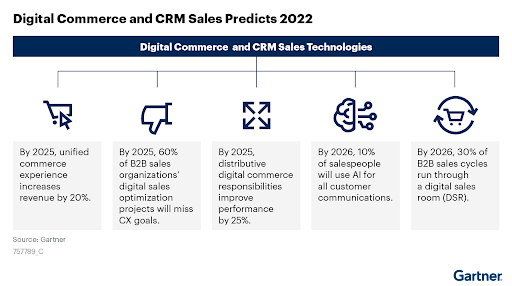
The Future of E-Commerce: Where Is It Heading and How to Handle It
For years the predictions claimed E-Com was going to eat brick-and-mortar’s breakfast, but the figures kept coming back, and brick-and-mortar still amounted to about 82% of all retail sales and the YoY shift remained small. Then the pandemic happened. Everything changed, and now we have to ride the tidal wave.
If you’d have told anyone working in retail – even the most ardent E-Com enthusiast – that there was going to be a jump of more than 25% in the adoption of online purchasing in 2020, it’s a safe bet that they wouldn’t have believed you.
So it’s no surprise that when 2020 happened, nobody was really prepared for it. But it’s the move everyone makes next that matters most, because even though the ‘everything’s shut, go home’ state of affairs is shifting, adoption of E-Commerce is predicted to keep growing:

The future of E-Commerce
Given this increase in digital purchasing (both in B2B and B2C), it’s no surprise that one of the key findings in Gartner’s: Predicts 2022: Buyers Dictate Your Selling Strategy was about digital commerce becoming a more integral part of the business:
“Leading organizations are evolving past digital commerce as a project and integrating it into every part of the business.”
So, E-Commerce has gone from: ‘we should have a team for that,’ to: ‘this is integral to how we do business.’ So far, so unsurprising. But how do we go beyond surviving in this new digital landscape and start thriving in it?
Well, here’s where the predictions come in:

Customer experience and new technology
The two biggest trends Gartner seems to be identifying are customer experience (CX) and the adoption of new technologies in order to hit business goals.
In fact, in B2B they’re identifying that many companies’ digital transformation efforts will be too internal facing, so fall short of CX goals. This is a big deal if their prediction that a unified customer experience increases revenue by 20% ends up coming true.
Now, there are clearly some great technologies that are going to be able to help companies deliver great CX, and Gartner has called two of them out: AI and digital sales rooms (DSRs).
One of the major problems with adding more systems and technologies to your business is that it increases the complexity of your business. We’ve spent the last 30 or so years building organizations on a foundation of hundreds of different systems that don’t play nicely with each other and CX is already paying the price.
We’ve all been in that situation where we’ve added a new solution to our tech stack and found that it’s solved one issue but caused another. Usually, because there’s a lack of visibility and interconnectivity (we’re looking at you RPA).
Getting better visibility and control in E-Commerce
This is why all businesses need to be thinking about how to improve the interconnectivity between the different sections of their organization. Because these new technologies have the potential to help you take this moment E-Commerce is having, and turn it into long-lasting success, but only if fully integrated into your processes.
One way to get this is through using a technology like process mining. It’s the fastest way to see exactly how your business is actually running, and create seamless processes that run through your current systems and any new ones you add.
So you can unlock greater business performance today, boost your CX, and integrate new technologies. So you create an E-Commerce solution that keeps customers coming back for more.
Want to see how we’re helping MediaMarktSaturn do just that? Check out this short video!






